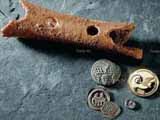Today.Az » Weird / Interesting » World's oldest music instrument - PHOTOS
15 May 2010 [13:50] - Today.Az
 The Divje Babe flute is a cave bear femur pierced by spaced holes that was found at the Divje Babe archeological park located near Cerkno in northwestern Slovenia. It has been suggested that it is the world’s oldest known musical instrument, but this is in dispute. The continuing dispute notwithstanding, the artifact remains on prominent public display as a flute in the National Museum of Slovenia (Narodni Muzej Slovenije) in Ljubljana. The museum’s visitor leaflet maintains that manufacture by Neanderthals “is reliably proven”.
The Divje Babe flute is a cave bear femur pierced by spaced holes that was found at the Divje Babe archeological park located near Cerkno in northwestern Slovenia. It has been suggested that it is the world’s oldest known musical instrument, but this is in dispute. The continuing dispute notwithstanding, the artifact remains on prominent public display as a flute in the National Museum of Slovenia (Narodni Muzej Slovenije) in Ljubljana. The museum’s visitor leaflet maintains that manufacture by Neanderthals “is reliably proven”.
Divje Babe (pron. Deew-yeh Bah-beh) is the oldest archaeological site in Slovenia. The site is the location of a horizontal cave, 45m long and up to 15 m wide. It is located 230m above the Idrijca river, near Cerkno, and is accessible to visitors. Researchers working at this site have uncovered more than 600 archaeological finds in at least ten levels, including 20 hearths, the skeletal remains of cave bears, and have studied climate change during the pleistocene. According to the museum, the alleged flute has been associated with the “end of the middle Pleistocene” and the time of Neanderthals, about 55,000 years ago
In 1995, Ivan Turk found an approximately 43,100 year-old juvenile cave bear femur at the Divje Babe site, near a Mousterian hearth. Because it has characteristics of a flute, he has called it the “Neanderthal flute”. Whether it is actually a flute created by Neanderthals is a subject of debate. It is broken at both ends, and has two complete holes and what may be the incomplete remains of one hole on each end, meaning that the bone may have had four or more holes before being damaged. The bone fragment is the diaphysis of the left femur of a one to two year-old cave bear, and is 113.6 mm in length. The maximum diameters of the two complete holes are 9.7 and 9.0 mm. The distance between the centers of the holes is 35 mm.
Soon after its publication, the status of the object as a musical instrument came under scrutiny by taphonomist Francesco d’Errico (et al., 1998), Holderman and Serangeli (1999), and Chase and Nowell (1998, 552), all of whom suggest it is more likely to be the result of carnivore chewing than Neanderthal construction. The bone has been damaged on all sides by the chewing of a carnivore.
If the bone is a flute it would be evidence of the existence of music 43,000 years ago, and of the making of music by Neanderthals. Thus Ivan Turk has asserted that whether the holes are of “artificial” (made by Neanderthals) or “natural” (punctures from a carnivore bite) origin is the “crucial question.”
Despite the disagreement about the bone’s markings, the bone has become a noted attraction in its Slovenian museum, publicized on official Slovenian websites and is a source of pride for the country. In the West, paintings were made, models constructed, and musicians such as Biology Professor and flautist Jelle Atema have played them publicly.
The arguments for one or the other interpretation are based on the available taphonomic evidence derived from direct study of the artifact, as well as related studies of Neanderthal tools and of carnivores of the time period.
/Bizarre Stuff/
Click photos to enlarge:


|
|